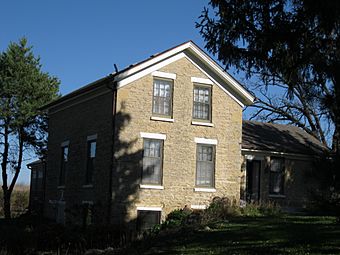Daniel Pond Farmhouse facts for kids
Quick facts for kids |
|
|
Daniel Pond Farmhouse
|
|

Daniel Pond Farmhouse
|
|
| Location | 76 US Hwy 14 Rutland, Wisconsin |
|---|---|
| Area | less than one acre |
| Built | 1850 |
| Architect | Sereno W. Graves |
| NRHP reference No. | 80000128 |
| Added to NRHP | June 30, 1980 |
The Daniel Pond Farmhouse, also called Eggleston Farm, is a historic house in Rutland, Wisconsin. It was built a long time ago, in the 1840s, using strong limestone walls. This special house was added to the National Register of Historic Places in 1980. This means it's an important building worth protecting.
Contents
A Look Back in Time
Early Settlers in Rutland
The first people to settle permanently in what is now Rutland arrived in 1842. They chose land near the old Janesville and Madison Road. This road is now known as US-14. Among these first settlers were the Dejeans, the Prentises, and Daniel Pond.
This area did not have many big rivers or lakes. Because of this, land buyers often passed it by. This made the land cheaper for farmers who did not have a lot of money. Daniel Pond came from Vermont. Many of his neighbors also came from Vermont. So, their community became known as the Vermont settlement.
Building the Farmhouse
Daniel Pond likely had the main part of his house built between 1844 and 1850. It was probably designed by Sereno W. Graves. Sereno Graves was a farmer who lived only a mile away. He later became a member of the Wisconsin State Assembly.
The house walls are made of small pieces of limestone. The corners have larger, carefully shaped stone blocks. A decorative wooden strip is at the top of the walls. This leads up to a roof that is not too steep. The windows have wooden sills and tops. Two smaller, one-story sections extend from the main house. They are built with the same type of stonework.
Life on the Pond Farm
The Daniel Pond Farmhouse was home to Daniel, his wife, and their two children. Daniel's widowed mother-in-law, Temperance Munger, also lived there with her son and daughter. A single man named Stewart Shampmore also lived on the farm.
By 1850, the Pond farm was doing very well. It was worth about $2,000, which was a lot of money back then. That year, the Ponds grew a lot of crops. They harvested 400 bushels of wheat and 150 bushels of corn. They also grew 500 bushels of oats, 150 bushels of potatoes, and 10 bushels of barley.
Their sixty sheep produced 300 pounds of wool. Their five cows gave them 100 pounds of cheese and 600 pounds of butter. This shows they were very successful farmers.
New Owners Through the Years
In 1854, James P. Kniffin and his family bought the farm. They continued to farm the land. They even added 60 pigs to the farm's animals. James retired in 1870 and gave the farm to his son, Lloyd.
Later, in 1874, John and Thomas Alsop bought the farm. Then, in 1893, the Petersons became the new owners.
The Peterson Family
Charles Peterson was born in Maribo, Denmark in 1861. He moved to America and Rutland with his family in 1869. He worked hard as a farm helper and saved his money. In 1883, he married Katie Hansen, who was also an immigrant from Denmark.
By 1889, Charles and Katie were able to buy 80 acres of land. Four years later, he sold that farm. He then bought the larger 193-acre Pond farm. By 1906, the Petersons had added another 160 acres to their farm.
They grew nine acres of tobacco, 100 acres of corn, and 50 acres of oats. They also grew 25 acres of hay. Over the years, Charles and Katie Peterson had ten children. Charles passed away in 1915, and Katie in 1930. However, the Peterson family continued to live on the farm until 1944.
Why This House is Special
The Daniel Pond Farmhouse was added to the National Register of Historic Places in 1980. It was also listed on the State Register of Historic Places in 1989. It is important because it is part of a group of unique stone buildings in the area. Other buildings include the Sereno W. Graves House, the Samuel Hunt House, and the Lockwood Barn.
The farm also shows how the area developed. First, settlers from New England, called Yankees, grew wheat. Later, in the late 1800s, Scandinavian immigrants took over the farms.

